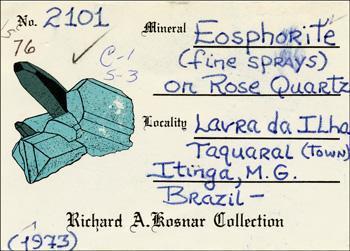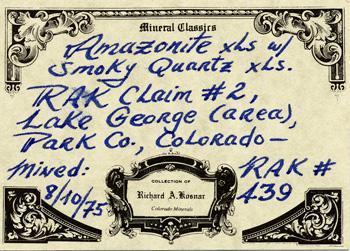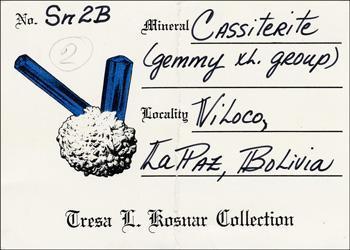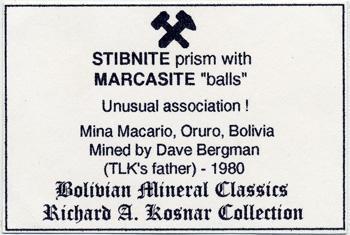Kosnar, Richard A. (1946-2007 )
Richard Andrew "Rich" Kosnar was born in Jersey City, New Jersey on November 13, 1946, the son of Mary Antoinette Fiamingo and Andrew William Kosnar, a construction contractor of Hungarian/Czech ancestry with family roots in the mining area of Zinnwald in Bohemia. Rich said he began collecting minerals and fossils as a youngster in 1957, and in 1963, made his first visit to a traprock quarry to collect zeolites and associated species, at the Upper New Street quarry in Paterson, New Jersey. He developed a love for traprock minerals and told of collecting at various other quarries in New Jersey from 1963 through 1971, including the Summit quarry and the world-famous Prospect Park quarry. He attended Upsala University to study mineralogy and geology, and also studied engineering for highway engineers at Rutgers. He later worked as the project engineer of the Route I-80 Roadcut, West Paterson Section (1969-1970), where traprock specimens were recovered during excavations for a new highway. Rich married his first wife, Linda Scarpone, in 1966, and together they had one son: Erik.Kosnar was also attracted to pegmatite localities, especially the minerals from Mt. Apatite, Auburn, Maine (1967), the Pulsifer quarry, Paris, Maine (1968), the Gillette quarry, Haddam Neck, Connecticut (1968), the Strickland quarry, Portland Township, Connecticut (1968), and the Slocum quarry in East Hampton, Connecticut (1968). He also collected specimens from the North Carolina emerald deposits (1970), and formally established his "Mineral Classics" company at his Keyport, New Jersey residence in 1970.
Kosnar visited Colorado in 1970 and moved there permanently in 1971. Over the following years he procured many thousands of superb specimens for museums and collectors throughout the U.S. and Europe. In Colorado he mined amazonite with Clarence Coil and his son every year from 1970 through 1986. During this period of time they discovered some of the finest color and quality amazonite crystal groups ever found, as well as albite, smoky quartz, goethite, fluorite, and many rare species at their various commercial claims.
In 1971 Kosnar began collecting classic European Alpine and worldwide "Alpine-type" specimens. During the 1970's and 1980's he also mined sapphire, ruby, and garnet in Montana. He had limited partnerships over the years with various collectors and dealers, and occasionally worked with dealer Walt Lidstrom. In 1972, he acquired and imported many specimens from the mines of Peru.
In 1976 Kosnar published an article in The Mineralogical Record with co-author Hal Miller, on "The Colorado Mineral Belt," following it in 1979 with an article on the Sweet Home mine. He mined the Dixie mine in Idaho Springs for leaf gold and crystallized gold in 1976, and that same year began importing mineral specimens from Bolivia's famous localities including Huanuni, Viloco, Llallagua, the San Jose mine in Oruro, Tasna, Morococala, Chicote Grande, and Cerro Rico de Potosí. It was from Potosí that he acquired a spectacular 6-inch twinned phosphophyllite crystal on matrix which is considered by some to be the finest mineral specimen in existence.
In 1977 Kosnar reopened the now-famous Sweet Home mine in Alma, Colorado to mine specimen rhodochrosite, hübnerite, fluorite, svanbergite and goyazite crystals. Other localities mined include the Calumet Iron mine; Italian Mountain; and Mt. Antero. In July 1979, several years before specimens were generally available to the public, he organized a mining expedition to the Sawtooth Mountains in Idaho to dig for gem aquamarine crystals, crystallized topaz, helvite, spessartine, smoky quartz, and feldspar. Following his divorce from Linda he married Tresa Bergman, the daughter of his mining partner, in 1979; together they had two sons, Brian and Brett.
Kosnar assembled one of the finest comprehensive collections of New Jersey traprock minerals in private hands, and also built a fine collection of old, rare Franklin and Sterling Hill minerals. His exceptional Colorado collection includes a fantastic suite of leaf and crystallized golds, fluorites, and rhodochrosites, as well as suites of minerals from Mt. Antero, the ore mines of the San Juan Mts. and the Leadville area, amazonite and associated species from the Crystal Peak area, and many antique and rare specimens.
In 1986 Kosnar became seriously and chronically ill with several diseases including Epstein-Barr Syndrome, and his traveling days ended. He became totally disabled, but continued to maintain his superb mineral collection. In the mid-1990's, with the help of his wife, he wrote a series of articles, published in Italian (he was fluent in an old Calabrian dialect of that language), about Colorado gold and its localities for the mineral magazine, Rivista Mineralogica Italiana.
Following a car accident in the 1980's and the gradual onset of his medical difficulties, the accuracy of Kosnar's labeling--primarily with regard to localities and provenance--became unreliable. All such data on his labels should be independently verified by current owners of his specimens.
During the 1970's, Kosnar imported several thousand mineral specimens from Brazil, including three new pegmatite phosphate species which were later named whiteite, Mn-whiteite and zanazziite. In 1993 a new pegmatite phosphate, kosnarite, from Oxford County, Maine was named by Kosnar's friend, the late Eugene E. Foord and others in recognition of his contributions to the mineralogical community. Kosnarite was later found in Brazil in the Jenipapo district. Kosnar assembled an extensive suite of some of the finest kosnarite specimens and also specimens of associated jahnsite, goyazite, quartz, albite and lepidolite.
Richard A. Kosnar died on January 15, 2007. Management of Kosnar's "Mineral Classics" dealership has been taken over by his son, Brian Kosnar, who has been a regular at major shows for several years, and travels to mineral localities in pursuit of specimens. His website is www.MinClassics.com.
Click to images to view larger
To contribute more information please E-mail us at:
minrecord@comcast.net
Citation format for this entry:
WILSON, Wendell E. 2022
Mineralogical Record
Biographical Archive, at www.mineralogicalrecord.com
minrecord@comcast.net
Citation format for this entry:
WILSON, Wendell E. 2022
Mineralogical Record
Biographical Archive, at www.mineralogicalrecord.com
64 x 89 mm,
A label dated 1973, depicting a Colorado amazonite, commemmorating Kosnar’s successful mining operations for amazonite.
64 x 90 mm,
Label for a specimen from the collection of Kosnar’s wife, Tresa, with artwork by Wendell Wilson.






